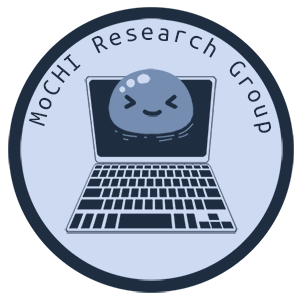Last updated on May 11, 2025
The Problem
Academic researchers encounter a variety of challenges when sharing their data such as confidentiality concerns, an evolving set of collaborators across different disciplines, and risks of data theft. While diverse technologies exist to facilitate data sharing, these problems persist because none of them are tailored to the specific needs of researchers. In 2021 researchers at MochiLab conducted a series of interviews with 38 academic researchers across 20 different fields to learn more about these challenges and collect the information necessary to build a tool tailored to the demands of collaborative research. These interviews provided a knowledge base which supported our development of DriveGroups.
Our Solution: DriveGroups
DriveGroups is an add-on to Google Drive built to facilitate better file sharing for academic researchers. We chose to create an add-on because most interviewees reported using and being familiar with Google Drive. This allows users to work with Google Drive while accessing DriveGroups as a sidebar which clearly displays its access control features. Researchers lamented that when sharing in their current platform they found it was inefficient to set sharing levels for many collaborators, confusing to navigate access control features, and unclear at times what is shared with whom. Informed by these challenges, our primary goals were to improve access control, transparency, ease of use, and error prevention. We designed DriveGroups to improve users’ knowledge of access control features by limiting the add-ons features to a core set of five capabilities accessible from one main menu: “Create a Group,” “Manage Groups,” “Share with a Group,” “Manage File Access,” and “Restore Archived Groups.” Additionally we introduced three capabilities to Google Drive designed to meet our demographic’s needs:
- Role Based Access Control: DriveGroups allows users to group their collaborators into groups such as students in different labs or classes, administrators, or collaborators at other institutions. This way when a collaborator leaves or joins the project, their access can be efficiently modified by adding or removing them from a group. Key to this feature is the fact that collaborators do not need to have DriveGroups themselves in order to gain and lose access to the files provided by their group.
Figure 1: The main menu of DriveGroups featuring the 5 key capabilities of the add-on
- Subgroups: DriveGroups allows users to create subgroups which inherit access from a parent group in order to automatically grant users access to the files shared with the parent group, but may provide higher access to some files. For instance, a parent group might be the entire lab, while a subgroup may be used for a specific project. This also makes it easy to move collaborators from one project to another without making any mistakes in the process of adding or removing access.
Figure 2: An example of the UI displaying a subgroup named “subgroup” and its parent group named “group”
- Dual Perspective Access Management: DriveGroups features two file sharing methods to help users track how their files are being shared using both the file and group perspectives as shown below. While Google Drive only allows users to select a file and see which users have access to it, DriveGroups provides the additional ability to see which files a specified group has access to, and to change these access levels from the group perspective.
Figure 3: Two access management perspectives available to DriveGroups users
Testing DriveGroup
We completed a beta version of DriveGroups in May of 2023, and ran a series of user studies over the summer. The results of our study were accepted to ACM Group 2025 and can be found at ACM Digital Library or through this link. For our studies we recruited 18 undergraduate research assistants via email and word of mouth. The students completed the following tasks both with DriveGroups and with Google Drive:
- Share your documents with your students, collaborators, and funding administrators at the appropriate access levels.
- Your collaborators work extensively with you one month and ask to contribute to report 3. Allow them to edit this document.
- Student A just graduated, remove his access to your files.
- You hire a new student. Their email is [redacted]. Give them access to files they need.
- You just discovered report 3 is from the wrong month, unshare it with your collaborators and administration.
- You’ve finished your research, remove access for all of your collaborators.
During this process students were asked to “think aloud,” and we took careful note of their thought processes as well as if they made any mistakes on either platform. Participants then completed a Qualtrics survey and semi structured interview to help us understand both how they rated the systems for different qualities, and why they provided these ratings. Our analysis of this data provides insights supporting the claim that DriveGroups outperforms Google Drive in each of 4 key areas: usability, access control, transparency, and error prevention.
Usability – 66% of users remarked that repetitiveness was a big issue for them when sharing files in Google Drive or complained as they completed the tasks that sharing files in Google Drive or checking their access required too much navigation. These users agreed that DriveGroups solved this issue. Additionally, 55% of participants explicitly stated that the role based access control helped them to complete tasks more efficiently than when using Google Drive.
Access Control – Participants rated DriveGroups statistically significantly higher than Google Drive on the statement: “I think the system allows me to restrict the access to some of my information to some people.” Furthermore, 61% of participants described DriveGroups’ access control features as helpful, easy to use, or reassuring. As one participant stated: “the fact that you can check the access of files by group and by files, it helps you double check if you made any mistakes.” This demonstrates that users benefit from multiple access perspectives when managing files.
Transparency – Participants also rated DriveGroups statistically significantly higher than Google Drive on the statement: “It is clear who is the audience of my shared information on the system.” One reason for this seems to be the two access management perspectives since half of our participants found checking file access in Google Drive to be tedious because they had to select each file individually to check which users had access to each one. Four Participants explicitly stated that the two file access perspectives made it clearer who had access to which files.
Error Prevention – Some features users commented on which they felt helped them prevent mistakes while using DriveGroups include: the presentation of all relevant group and file information when modifying access, the separation of the features for sharing new files from the features for modifying existing access, and the ability to undo most actions immediately after executing them, such as with the “Restore Archived Groups” window which allows users to bring back recently deleted groups within 24 hours of their deletion. 55% of participants endorsed the convenience of DriveGroups’ error recovery features.
Recent Work and Next Steps
Since our initial study we have updated DriveGroups in preparation for a follow-up study. Some of these edits are direct responses to user input. A common issue for users was confusion over whether their actions (ex. Deleting a Group) corresponded to their expected results (ex. group members losing access to files in the group). It seems, therefore, that the task of group management is not intuitive to new users. To combat this we integrated clearer instructions and pop-up notifications to reassure users. Additionally, we added some new features which we anticipated users desiring for a more day-to-day context. For instance, the subgroups I described earlier were not featured in our beta version. We also introduced the ability to share folders alongside files, a feature that could be avoided in our isolated studies, but would not be practical for our users. We also thoroughly edited our UI for consistency and clarity.
We are currently in the process of conducting a diary study to analyze how the group perspective might change the ways researchers think about and practice data sharing. Our hope is that the improved transparency and efficiency of group sharing will motivate users to share data more freely with their collaborators and effectively manage the levels of access different types of collaborators have. In these ways DriveGroups has potential to promote closer collaboration between academic researchers and their partners.


